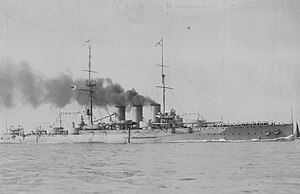
Back Рюрик II (броненосен крайцер) Bulgarian Rjurik (1906) Czech Rurik (Schiff, 1908) German Rurik (1908) Spanish Riourik (croiseur, 1906) French Rurik (incrociatore 1906) Italian リューリク (装甲巡洋艦・2代) Japanese «Rurik» (1906) NB Ruryk (1906) Polish Rurik (cruzador de 1906) Portuguese
 Rurik after the installation of her pole fore mast
| |
| Class overview | |
|---|---|
| Preceded by | Bayan class |
| Succeeded by | None |
| History | |
| Name | Rurik |
| Namesake | Rurik |
| Awarded | June 1905 |
| Builder | Vickers |
| Laid down | 22 August 1905 |
| Launched | 17 November 1906 |
| Out of service | October 1918 |
| Stricken | 1 November 1923 |
| Fate | Broken up, 1924–1925 |
| General characteristics | |
| Type | Armored cruiser |
| Displacement | 15,190 long tons (15,430 t) |
| Length | 161.23 m (529 ft) loa |
| Beam | 22.86 m (75 ft) |
| Draft | 7.92 m (26 ft) |
| Installed power |
|
| Propulsion | 2 × triple-expansion steam engines |
| Speed | 21 knots (39 km/h; 24 mph) |
| Range | 6,100 nautical miles (11,300 km; 7,000 mi) at 10 kn (19 km/h; 12 mph) |
| Crew |
|
| Armament |
|
| Armor | |
Rurik was the last armored cruiser to be built for the Imperial Russian Navy. The ship was designed by the British firm Vickers and built in their shipyard, being laid down in 1905 and completed in 1908. She was armed with a main battery of four 254 mm (10 in) guns and a secondary battery of eight 203 mm (8 in) guns; her top speed was rated at 21 knots (39 km/h; 24 mph). Despite her powerful gun armament, Rurik was rendered obsolescent even before she was completed by the advent of the British battlecruisers of the Invincible class, which were more powerfully armed and faster. Her design is nevertheless well regarded and naval historians rate her as one of the best vessels of her type ever built.
Rurik served as the flagship of the Russian Baltic Fleet for much of her relatively short career. She made one overseas cruise with a trip to the Mediterranean Sea in mid-1910, but spent the rest of her early career in the Baltic Sea. After the start of World War I, she operated with the other cruisers of the fleet, making raids on German positions in the southern Baltic, and after being modified to carry naval mines, took part in laying offensive minefields to block German naval traffic. She saw one major action, the Battle of Åland Islands, in July 1915. There, she engaged three German cruisers; she failed to score any hits and was struck several times, though she was not seriously damaged and her presence convinced the Germans to retreat.
The ship was badly damaged by a German mine in November 1916 and spent the next several months under repair. During that period out of service, the Russian Revolution toppled the Imperial government and ultimately led to the Bolshevik seizure of power late that year. The resulting Treaty of Brest-Litovsk ended the war for Russia and Rurik was laid up in Kronstadt in October 1918. She lingered there for another three years in a state of preservation, but by November 1923, she was in poor condition. The new Soviet Navy decided to break up the ship and she was towed to Petrograd, being scrapped there between 1924 and 1925.
© MMXXIII Rich X Search. We shall prevail. All rights reserved. Rich X Search